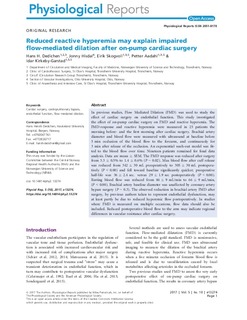| dc.contributor.author | Dedichen, Hans Henrik | |
| dc.contributor.author | Hisdal, Jonny | |
| dc.contributor.author | Skogvoll, Eirik | |
| dc.contributor.author | Aadahl, Petter | |
| dc.contributor.author | Kirkeby-Garstad, Idar | |
| dc.date.accessioned | 2018-01-23T09:40:12Z | |
| dc.date.available | 2018-01-23T09:40:12Z | |
| dc.date.created | 2017-12-05T13:53:15Z | |
| dc.date.issued | 2017 | |
| dc.identifier.citation | Physiological Reports. 2017, 5:e13274 (10), 1-7. | nb_NO |
| dc.identifier.issn | 2051-817X | |
| dc.identifier.uri | http://hdl.handle.net/11250/2478960 | |
| dc.description.abstract | In previous studies, Flow Mediated Dilation (FMD) was used to study the effect of cardiac surgery on endothelial function. This study investigated the effect of on‐pump cardiac surgery on FMD and reactive hyperemia. The FMD‐response and reactive hyperemia were measured in 25 patients the morning before‐ and the first morning after cardiac surgery. Brachial artery diameter and blood flow were measured with ultrasound at baseline before 5 min occlusion of the blood flow to the forearm, and continuously for 3 min after release of the occlusion. An exponential wash‐out model was fitted to the blood flow over time. Nineteen patients remained for final data analysis. Data are mean ± SEM. The FMD response was reduced after surgery from 3.3 ± 0.5% to 1.4 ± 0.6% (P = 0.02). Max blood flow after cuff release was reduced from 342 ± 30 mL preoperatively to 305 ± 30 mL postoperatively (P < 0.00) and fell toward baseline significantly quicker; preoperative half‐life was 36 ± 2.4 sec. versus 29 ± 1.9 sec postoperatively (P < 0.00). Resting blood flow was reduced from 84 ± 9 mL/min to 66 ± 9 mL/min, (P < 0.00). Brachial artery baseline diameter was unaffected by coronary artery bypass surgery (P = 0.3). The observed reduction in brachial artery FMD after surgery, by previous authors taken to represent endothelial dysfunction, may at least partly be due to reduced hyperemic flow postoperatively. In studies where FMD is measured on multiple occasions, flow data should also be included. Reduced postoperative blood flow to the arm may indicate regional differences in vascular resistance after cardiac surgery. | nb_NO |
| dc.language.iso | eng | nb_NO |
| dc.publisher | Wiley Open Access | nb_NO |
| dc.rights | Navngivelse 4.0 Internasjonal | * |
| dc.rights.uri | http://creativecommons.org/licenses/by/4.0/deed.no | * |
| dc.title | Reduced reactive hyperemia may explain impaired flow-mediated dilation after on-pump cardiac surgery | nb_NO |
| dc.type | Journal article | nb_NO |
| dc.type | Peer reviewed | nb_NO |
| dc.description.version | publishedVersion | nb_NO |
| dc.source.pagenumber | 1-7 | nb_NO |
| dc.source.volume | 5:e13274 | nb_NO |
| dc.source.journal | Physiological Reports | nb_NO |
| dc.source.issue | 10 | nb_NO |
| dc.identifier.doi | 10.14814/phy2.13274 | |
| dc.identifier.cristin | 1523067 | |
| dc.description.localcode | © 2017 The Authors. Physiological Reports published by Wiley Periodicals, Inc. on behalf of The Physiological Society and the American Physiological Society. This is an open access article under the terms of the Creative Commons Attribution License, which permits use, distribution and reproduction in any medium, provided the original work is properly cited. | nb_NO |
| cristin.unitcode | 194,65,25,0 | |
| cristin.unitname | Institutt for sirkulasjon og bildediagnostikk | |
| cristin.ispublished | true | |
| cristin.fulltext | original | |
| cristin.qualitycode | 1 | |

